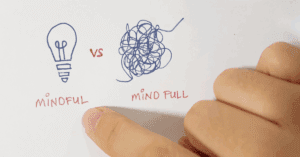Mindfulness meditation has grown remarkably in recent years. This shift reflects something: mindfulness brings benefits that reach far beyond simple stress relief. Facing a health diagnosis can leave you feeling lost in a sea of worry and fear. Mindfulness meditation genuinely helps seniors. It significantly reduces depression in older adults. Mindful aging means more than just getting by—it’s about finding ways to flourish even when life feels uncertain. Your life holds meaning beyond any medical label and mindfulness can open paths to a richer senior living experience right here in Eau Claire.
Mindfulness as a Path to Inner Peace After a Diagnosis
Letting go of fear and uncertainty
When you stop fighting difficult feelings, something surprising happens—they become easier to bear. Try this gentle approach when worried thoughts start spinning:
- Simply notice them without deciding they’re right or wrong
- Name what you’re experiencing: “I’m feeling scared right now”
- Let those feelings exist without pushing them away
- Watch them shift and change, like weather moving across the sky
This creates breathing room between what happens and how you respond. You get to choose your next step instead of feeling swept away by whatever emotion shows up first.
Finding calm in the present moment
Your mind naturally wants to solve problems, which often means racing toward tomorrow’s worries or yesterday’s regrets. Mindfulness gently brings your attention back to right now, to this breath, this moment where life actually happens. Focusing on one simple thing, like breathing, helps quiet the mental chatter that feeds stress. Mindfulness also helps you see the difference between what you can influence and what lies beyond your control. Rather than exhausting yourself trying to predict every possible outcome, you learn to rest in this moment—finding stability even when everything else feels uncertain.
Reconnecting with Purpose and Identity Through Mindfulness
Mindful aging and self-discovery
Your diagnosis doesn’t define you, though it might feel that way some days. Mindfulness helps you step back and see the bigger picture of who you are. When you observe your thoughts and feelings without getting caught up in them, you start to remember the values, interests and qualities that make you uniquely you.
Creating meaning beyond medical labels
Medical appointments and treatment schedules can start to feel like they’re running your life. Mindfulness helps you create some breathing room between yourself and these labels. Psychologists call this “decentering”—your ability to step outside your immediate experience and see it more objectively. This practice also nurtures self-compassion, which research shows directly supports better self-regulation. Instead of being harsh with yourself about limitations, you learn to treat yourself with the same kindness you’d show a good friend.
Mindfulness invites you to focus on today’s opportunities rather than yesterday’s losses or tomorrow’s worries. Your life has purpose and meaning that extends far beyond any diagnosis—mindfulness just helps you remember that truth.
Simple Ways to Begin a Mindful Lifestyle
Start with mindful breathing
Mindful breathing forms the heart of most mindfulness practices. Begin with just 5-10 minutes daily—even this small commitment can make a real difference. Diaphragmatic breathing (you might know it as belly breathing) engages your diaphragm, that powerful muscle at the base of your lungs. This gentle technique can:
- Lower blood pressure and heart rate
- Reduce stress by activating your body’s relaxation response
- Benefit those with lung conditions and anxiety
Try body scans or gentle movement
Body scan meditation means slowly focusing your attention on different parts of your body, one at a time, just noticing whatever sensations arise without judging them. You might begin by paying attention to your feet, then gradually work your way up to your head. Mindful movement—gentle stretching or walking—offers another wonderful path to practice. Taking mindful walks outdoors provides extra benefits for your overall well-being.
Use apps or guided meditations
Apps can provide helpful structure and variety, offering guided sessions for every skill level. Headspace, Calm and Insight Timer are popular choices that include everything from brief breathing exercises to longer meditation programs. These tools put mindfulness at your fingertips whenever you need it.
Adapt practices to your comfort level
Most importantly, shape your mindfulness practice around your own needs and abilities. If sitting meditation feels uncomfortable, try mindful activities like coloring, gardening or mindful eating. Remember, this journey is about growth, not about reaching perfection.
Embracing Mindfulness on Your Journey
What makes mindfulness beautiful is how it meets you exactly where you are. Some days, you might manage just a few mindful breaths. Others, you might feel ready for longer practices or group activities. Both are perfectly valuable. This isn’t about perfection—it’s about showing up for yourself with kindness. Every moment you choose presence over worry, connection over isolation or curiosity over judgment matters more than you might realize.
Yes, life after a diagnosis brings real challenges. But it also holds possibilities for deeper meaning and richer relationships than you may have imagined. Mindfulness can walk alongside you through both the difficult days and the surprisingly beautiful ones. Contact us at (715) 831-9118 to learn more about Heritage at Oakwood Hills, our assisted living community in Eau Claire, WI.
FAQs
Q1. How can mindfulness help after receiving a health diagnosis? Mindfulness can help you find inner peace by teaching you to accept emotional pain, observe thoughts without judgment and focus on the present moment. This practice creates space between stimulus and response, allowing you to choose how you react rather than being driven by automatic emotional responses.
Q2. What are some ways to practice mindfulness? You can begin with mindful breathing for 5-10 minutes daily, try body scans or gentle movement, join a mindfulness group or class, use apps or guided meditations or adapt practices to your comfort level. Even activities like mindful coloring, gardening or eating can be effective ways to incorporate mindfulness into your daily routine.



